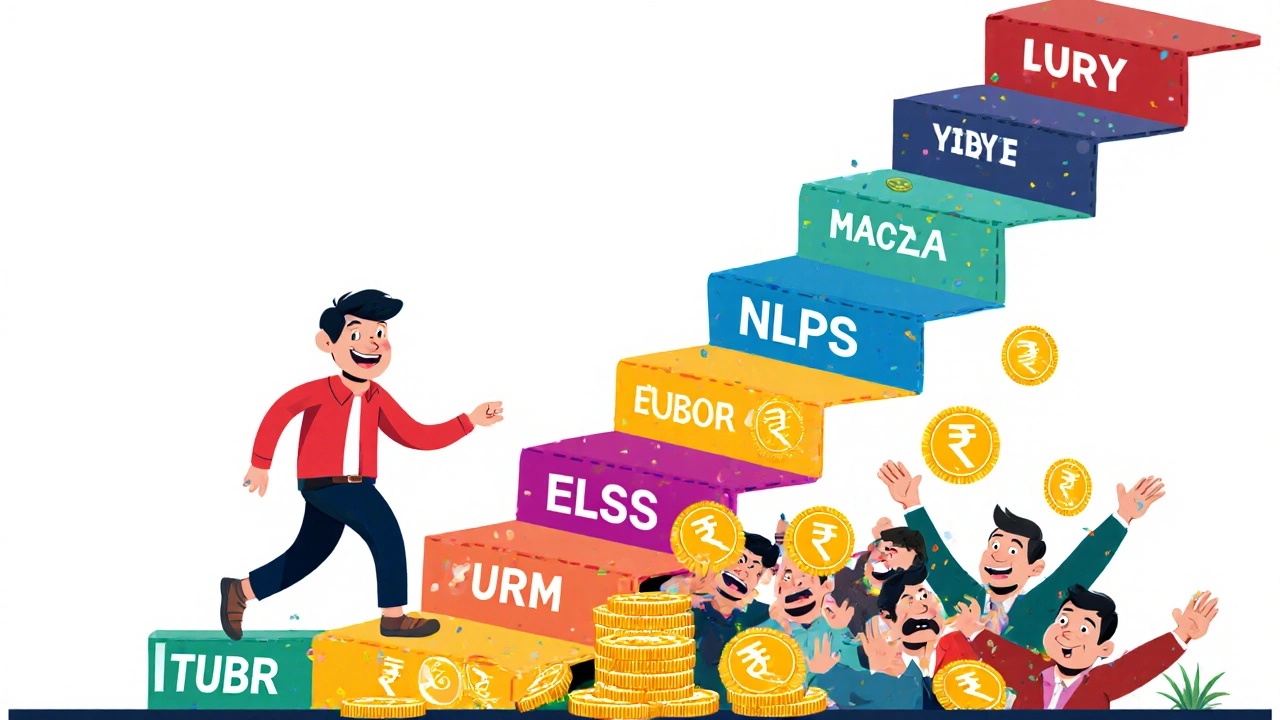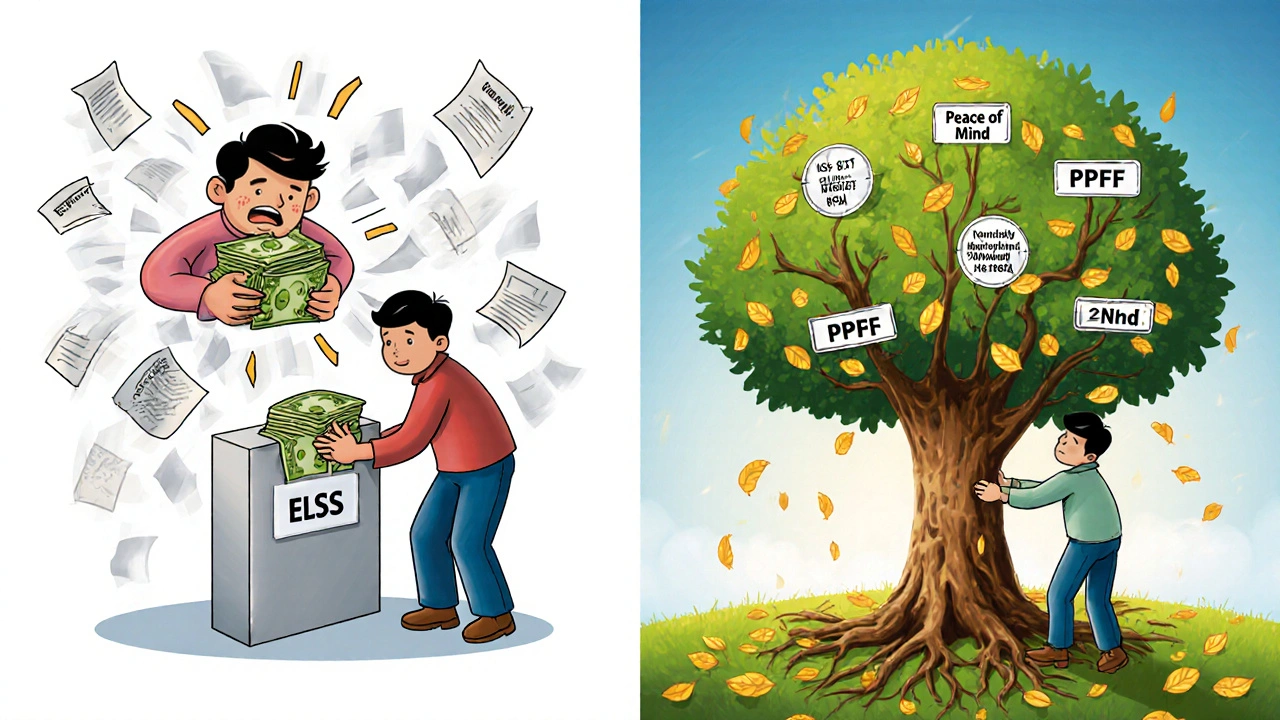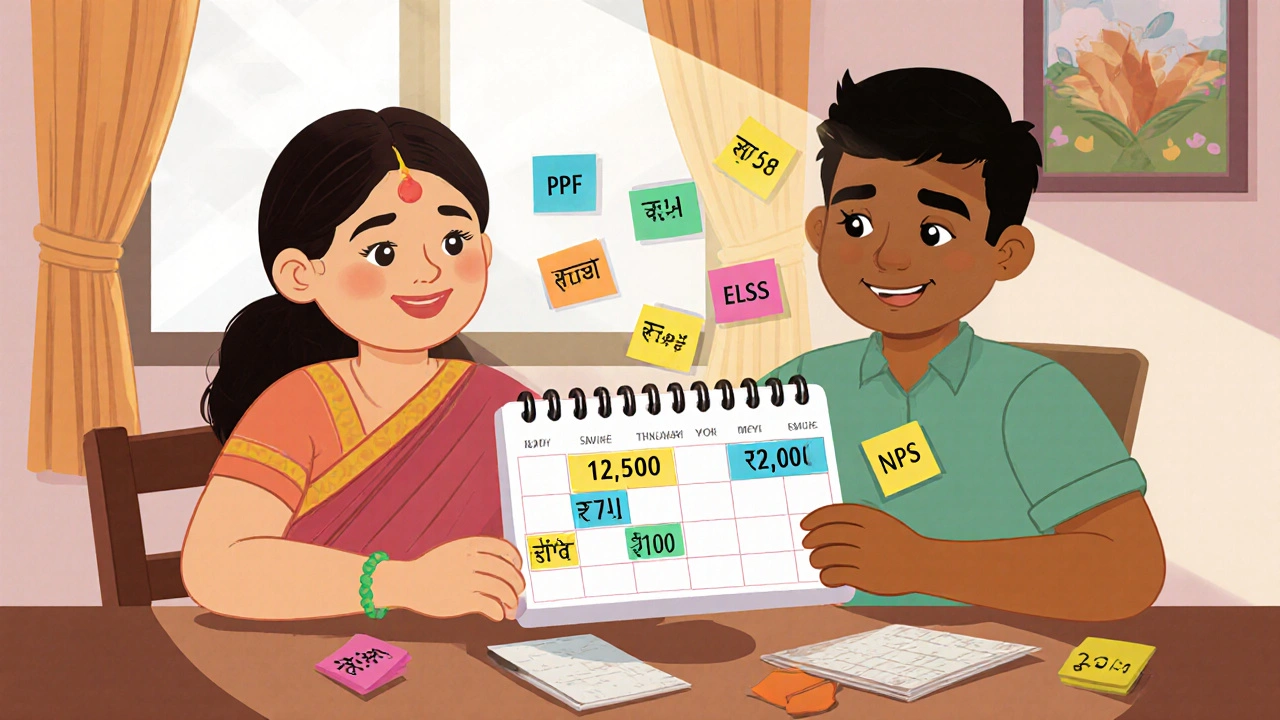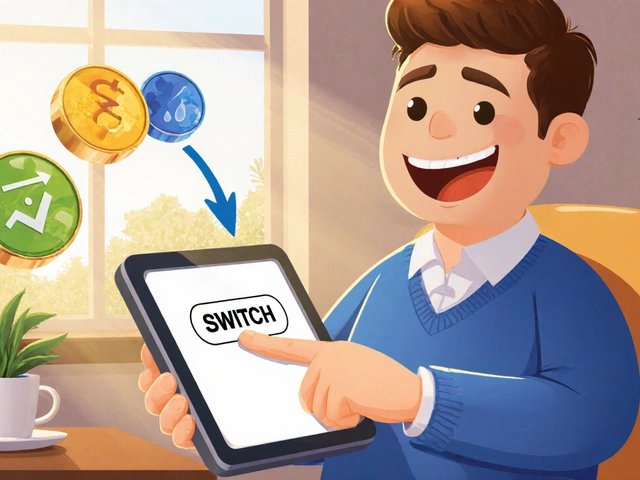Section 80C Investment Ladder in India: Spread Your Contributions Across the Year to Maximize Tax Savings
Every year, millions of Indian taxpayers rush to invest in Section 80C options in March. They panic because they’ve left it too late. They pick one or two instruments, dump in the full ₹1.5 lakh, and hope for the best. But here’s the truth: Section 80C isn’t a one-time race. It’s a year-long race you can win by pacing yourself.
Why the Section 80C Ladder Works Better Than a Lump Sum
Putting all your ₹1.5 lakh into one investment at the end of the year isn’t just stressful-it’s financially risky. What if the market crashes in March? What if your chosen ELSS fund underperforms? What if you forget to submit proof and lose the deduction? The lump-sum approach forces you to make big decisions under pressure, with no room to adjust. A Section 80C investment ladder changes all that. Instead of one big move, you spread your contributions evenly across the year. You invest ₹12,500 every month. That’s it. No panic. No last-minute scrambling. And here’s why it’s smarter:- You avoid market timing risk-your money enters the market gradually, smoothing out price swings.
- You build discipline. Monthly investing becomes a habit, not a chore.
- You reduce stress. No more March tax panic.
- You unlock compounding earlier. Every rupee invested in January has 11 more months to grow than one invested in February.
This isn’t theory. A 2024 study by the National Stock Exchange showed that investors using a monthly SIP approach in ELSS funds over five years had 8.3% higher average returns than those who invested lump sums in March, even when the total amount invested was identical.
How to Build Your Section 80C Ladder
Start simple. You have ₹1.5 lakh to invest under Section 80C. Divide it by 12. That’s ₹12,500 per month. Now, pick 3-4 eligible instruments and assign them to different months. Here’s a practical example:- January - ₹5,000 into PPF (Public Provident Fund). This locks in long-term growth and gives you tax-free returns.
- February - ₹3,000 into NPS (National Pension System). You get an extra ₹50,000 deduction under Section 80CCD(1B), so this doubles your benefit.
- March - ₹4,000 into ELSS (Equity Linked Savings Scheme). Use SIPs to avoid timing the market.
- April - ₹5,000 into life insurance premium (if you need coverage).
- May - ₹3,000 into tuition fees for your children.
- June - ₹5,000 back into PPF.
- July - ₹3,000 into NPS.
- August - ₹4,000 into ELSS.
- September - ₹5,000 into home loan principal repayment.
- October - ₹3,000 into NPS.
- November - ₹4,000 into ELSS.
- December - ₹5,000 into PPF.
This adds up to ₹1.5 lakh. But more importantly, you’ve diversified across asset classes, timing, and liquidity needs.
Best Instruments for Your Ladder
Not all Section 80C options are created equal. Some are better for steady growth. Others are better for flexibility. Here’s how to pick:| Instrument | Lock-in Period | Expected Return | Liquidity | Best For |
|---|---|---|---|---|
| PPF | 15 years | 7.1%-7.5% (govt-backed) | Low (partial withdrawals after 7 years) | Long-term safety, tax-free income |
| ELSS | 3 years | 12%-15% (historical average) | Medium (redeem after 3 years) | Growth seekers, market exposure |
| NPS | Until 60 | 9%-12% (market-linked) | Very low (only 20% lump sum at retirement) | Retirement planning, extra deduction |
| Life Insurance (Term) | Varies (usually 5+ years) | 4%-6% (mostly for insurance, not returns) | Low | Those needing coverage, not just tax savings |
| Home Loan Principal | None (linked to loan term) | Equivalent to loan interest rate | High (if you sell property) | Homeowners with active loans |
Use PPF for safety, ELSS for growth, and NPS for retirement depth. Avoid insurance plans just for tax savings unless you actually need life cover. Most people don’t.

Common Mistakes to Avoid
Even smart investors mess up their 80C ladder. Here’s what to watch out for:- Overloading on ELSS. ELSS is popular, but it’s volatile. Don’t put all ₹1.5 lakh here. You’re gambling your tax savings on market luck.
- Ignoring NPS. The extra ₹50,000 deduction under 80CCD(1B) is free money. If you’re in the 30% tax bracket, that’s ₹15,000 saved in taxes-just for investing ₹50,000 more.
- Forgetting proof submission. Banks and employers need proof of investment. Keep screenshots, receipts, and statements. Don’t assume they’ll track it.
- Investing too late in the year. If you wait until December, you lose the compounding advantage. Start in January.
- Using the wrong account. PPF must be in your name or your child’s name. You can’t use your spouse’s account for your deduction.
What If You Can’t Invest ₹12,500 Every Month?
Life happens. Your income dips. Your kid needs braces. Your car breaks down. That’s okay. The ladder doesn’t require perfection. Adjust.- If you miss a month, make it up in the next. Don’t skip the whole year.
- Use variable amounts. Invest ₹15,000 in months you earn extra, ₹8,000 in lean months.
- Focus on hitting ₹1.5 lakh total. The monthly rhythm helps, but the annual total matters most.
- Use auto-debit. Set up SIPs for ELSS and NPS. Let the system work for you.
One client I know-middle-income, two kids-used to invest ₹50,000 in March. Last year, she started a staggered plan: ₹10,000 in PPF, ₹7,000 in ELSS, and ₹3,000 in NPS every month. She ended up saving ₹18,000 more in taxes because she didn’t miss a single month, and her ELSS returns were 14.2% instead of 8.9% from her lump-sum March buy.

When to Rebalance Your Ladder
Your ladder isn’t static. Every year, review it:- Did you max out? If yes, great. If not, why? Was it cash flow? Confusion? Lack of discipline?
- Did any instrument underperform? Maybe your ELSS fund consistently trails its benchmark. Switch next year.
- Did your life change? Got a new child? Bought a house? Added NPS? Adjust your allocation.
- Did tax laws change? In 2023, the NPS deduction was clarified. In 2024, some mutual fund houses reduced ELSS expense ratios. Stay updated.
Rebalancing doesn’t mean changing everything. It means tweaking. Maybe you drop life insurance this year because you’re now covered under your employer. Maybe you increase PPF because you’re nearing retirement.
Final Tip: Track Everything
You can’t manage what you don’t measure. Use a simple spreadsheet or a free app like ClearTax or ETMoney to track:- Which instrument you invested in
- How much
- When
- Receipt number
- Proof stored (cloud or physical)
When your employer asks for proof in March, you’ll have it ready. No stress. No last-minute calls to your broker.
Section 80C Isn’t About Tax Avoidance. It’s About Building Wealth.
The ₹1.5 lakh deduction is just the surface. The real win is what happens after you invest. PPF grows tax-free for 15 years. ELSS compounds over decades. NPS becomes your retirement anchor. The ladder isn’t just a tax trick. It’s a wealth-building rhythm.Stop treating tax season like a fire drill. Start treating it like a monthly habit. Spread your money. Stay calm. Let time work for you. That’s how real financial freedom is built-in small, steady steps, not one desperate leap in March.
Can I invest more than ₹1.5 lakh under Section 80C?
You can invest more than ₹1.5 lakh, but only the first ₹1.5 lakh qualifies for tax deduction under Section 80C. Any extra amount won’t reduce your taxable income. However, you can still invest beyond this limit for long-term growth-just without the tax benefit. For example, investing ₹2 lakh in ELSS will give you ₹1.5 lakh in tax savings, but the extra ₹50,000 still grows tax-efficiently.
Is PPF better than ELSS for Section 80C?
It depends on your goal. PPF is safer, with guaranteed returns around 7.1%-7.5% and completely tax-free maturity. ELSS offers higher returns-historically 12%-15%-but comes with market risk and a 3-year lock-in. If you want safety and steady growth, go with PPF. If you’re young, have a long horizon, and can handle volatility, ELSS gives you better wealth-building potential. Most investors use both.
Can I claim Section 80C deductions if I’m a salaried employee?
Yes. Salaried employees can claim Section 80C deductions through their employer by submitting investment proofs before the deadline (usually February). If you miss that, you can still claim it while filing your income tax return. Your employer’s payroll system will adjust your TDS based on your declarations, but the final deduction is processed during ITR filing.
What happens if I withdraw from PPF before 15 years?
You can make partial withdrawals after completing 7 years, but only up to 50% of the balance at the end of the 4th year. Full withdrawal is only allowed at maturity (15 years). Early closure is permitted only in case of death or critical illness, and even then, with documentation. PPF is designed for long-term savings, so treat it as such.
Can I invest in ELSS through SIP and still claim Section 80C?
Absolutely. SIPs in ELSS funds are fully eligible for Section 80C deductions. Each monthly installment counts as a separate investment, and you can claim the total amount invested in a financial year. This is why SIPs are the ideal tool for building a Section 80C ladder-automated, consistent, and tax-efficient.
Do I need to invest in all 80C options to maximize savings?
No. You don’t need to use every option. The goal is to reach ₹1.5 lakh in eligible investments using the instruments that fit your financial goals. Many people use just two: PPF and ELSS. Others add NPS or home loan principal. The key is diversification across asset types, not filling every box.
Is Section 80C changing in 2026?
As of now, there are no official changes announced for Section 80C in the 2026 budget. The ₹1.5 lakh limit has remained unchanged since 2014. However, the government has been encouraging NPS and digital investments. Always check the official Income Tax Department website or consult a CA before investing, as rules can shift with budget announcements.





